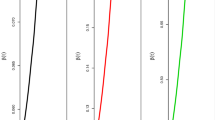Abstract
Recent experience has shown that interior-point methods using a log barrier approach are far superior to classical simplex methods for computing solutions to large parametric quantile regression problems. In many large empirical applications, the design matrix has a very sparse structure. A typical example is the classical fixed-effect model for panel data where the parametric dimension of the model can be quite large, but the number of non-zero elements is quite small. Adopting recent developments in sparse linear algebra we introduce a modified version of the Frisch-Newton algorithm for quantile regression described in Portnoy and Koenker[28]. The new algorithm substantially reduces the storage (memory) requirements and increases computational speed. The modified algorithm also facilitates the development of nonparametric quantile regression methods. The pseudo design matrices employed in nonparametric quantile regression smoothing are inherently sparse in both the fidelity and roughness penalty components. Exploiting the sparse structure of these problems opens up a whole range of new possibilities for multivariate smoothing on large data sets via ANOVA-type decomposition and partial linear models.
Similar content being viewed by others
References
Barrodale, I., Roberts, F. Solution of an overdetermined system of equations in the _1 norm. Communications of the ACM, 17: 319–320 (1974)
Breiman, L. The Π method for estimating multivariate functions from noisy data (Disc: 145–160). Technometrics, 33: 125–143 (1991)
Duff, I.S. Sparse numerical linear algebra: direct methods and preconditioning. I.S. Du., G.A. Watson (Eds.) The State of the Art in Numerical Analysis, Oxford University Press, Oxford, 27–62 1997
Duff, I.S. Matrix methods. RAL-TR-1998-076, Department of Computation and Information, Rutherford Appleton Laboratory, Oxon., 1998
Duff, I.S., Heroux, M.A., Pozo, R. An overview of the sparse basic linear algebra subprograms: The new standard from the BLAS technical forum. ACM Transactions on Mathematical Software, 28: 239–267 (2002)
Friedman, J.H. Multivariate adaptive regression splines (Disc: 67–141). The Annals of Statistics, 19: 1–67 (1991)
Frisch, R. The logarithmic potential method of convex programming. Technical Report, University Institute of Economics, Oslo, Norway, 1955
Golub, H.G., van der Vorst, H.A. Closer to the solution: iterative linear solvers. I.S. Duff and G.A. Watson (Eds.), The State of the Art in Numerical Analysis, Oxford University Press, Oxford, 63–92 1997
Gonzaga, C., Path-following methods for linear programming, SIAM Review, 34: 167–224 (1992)
Gu, C.,Bates, D.M., Chen, Z., Wahba, G. The computation of generalized cross-validation functions through Householder tridiagonalization with applications to the .tting of interaction spline models. SIAM Journal on Matrix Analysis and Applications, 10: 457–480 (1989)
Gupta, A. Recent advances in direct methods for solving unsymmetric sparse systems of linear equations. ACM Trans. Math. Software, 28: 301–324 (2002)
Hansen, M., Kooperberg, C., Sardy, S. Triogram models. Journal of the American Statistical Association, 93: 101–119 (1998)
Haunschmid, E.J., Ueberhuber, C.W. Direct Solvers for Sparse Systems. Tech. Report AURORA TR1999- 18, Vienna University of Technology, 1999
He, X., Ng, P. COBS: qualitatively constrained smoothing via linear programming. Computational Statistics, 14: 315–337 (1999)
He, X., Ng, P., Portnoy, S. Bivariate Quantile Smoothing Splines. J. Royal Stat. Soc., 60: 537–550 (1998)
He, X., Shi, P. Bivariate tensor-product B-splines in a partly linear model. Journal of Multivariate Analysis, 58: 162–181 (1996)
Karmarker, N. A new polynomial time algorithm for linear programming. Combinatorica, 4: 373–395 (1984)
Koenker, R., Mizera, I. Penalized triograms: Total variation regularization for bivariate smoothing. Journal of the Royal Statistical Society (B), 66: 145–163 (2004)
Koenker, R., Ng, P. SparseM: a sparse matrix package for R. Journal of Statistical Software, 8: 2003
Koenker, R., Ng, P. Inequality constrained quantile regression, manuscript, 2004
Koenker, R., Ng, P., Portnoy, S. Quantile Smoothing Splines. Biometrika, 81, 673–80 (1994)
Koenker, R., d’Orey, V. Computing regression quantiles. Applied Statistics, 36: 383–393 (1987)
Koenker, R., d’Orey V. A remark on algorithm AS 229: Computing dual regression quantiles and regression rank scores. Applied Statistics, 43: 410–414 (1994)
Liu, J. W-H. Modi.cation of the minimum degree algorithm by multiple elimination. ACM Trans. Math. Software, 11: 141–153 (1985)
Lustig, I.J., Marsten, R.E., Shanno, D.F. On implementing Mehrotra’s predictor-corrector interior-point method for linear programming. SIAM Journal of Optimization, 2435–449 (1992)
Lustig, I.J., Marsten, R.E., Shanno, D.F. Interior point methods for linear programming: Computational state of the art. ORSA Journal on Computing, 6: 1–14 (1994)
Ng, E.G., Peyton, B.W. Block sparse Cholesky algorithms on advanced uniprocessor computers. SIAM J. Sci. Comput., 14: 1034–1056 (1993)
Portnoy, S., Koenker, R. The Gaussian hare and the Laplacian tortoise: computability of squared-error vs absolute error estimators, (with discussions). Statistical Science, 12: 279–300 (1997)
Saad, Y. Sparskit: A basic tool kit for sparse matrix computations, Version 2, available from (1994) www.cs.umn.edu/Research/arpa/SPARSKIT/sparskit.html
Saad, Y., van der Vorst, H. Iterative solution of linear systems in the 20-th century. Journal of Computational and Applied Mathematics, 123: 1–33 (2000)
Wright, S. Primal-Dual Interior-Point Methods. Society for Industrial and Applied Mathematics, Philadelphia, 1997
Author information
Authors and Affiliations
Corresponding author
Additional information
This research was partially supported by NSF grant SES-02-40781.
Rights and permissions
About this article
Cite this article
Koenker, R., Ng, P. A Frisch-Newton Algorithm for Sparse Quantile Regression. Acta Mathematicae Applicatae Sinica, English Series 21, 225–236 (2005). https://doi.org/10.1007/s10255-005-0231-1
Received:
Issue Date:
DOI: https://doi.org/10.1007/s10255-005-0231-1



